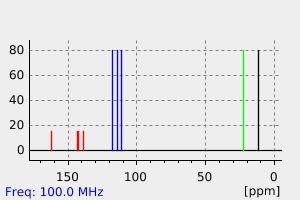(9ci)-2-乙基-5-硝基-1H-苯并咪唑 | 5805-42-5
中文名称
(9ci)-2-乙基-5-硝基-1H-苯并咪唑
中文别名
——
英文名称
2-ethyl-5-nitrobenzimidazole
英文别名
5-nitro-2-ethyl-1H-benzo[d]imidazole;2-ethyl-5-nitro-1H-benzo[d]imidazole;2-ethyl-5-nitro-1H-benzimidazole;5-nitro-2-ethylbenzimidazole;2-ethyl-5-nitro-1(3)H-benzoimidazole;2-Aethyl-5-nitro-1(3)H-benzimidazol;2-ethyl-5(6)-nitro-benzimidazole;2-ethyl-6-nitro-1H-benzimidazole
CAS
5805-42-5
化学式
C9H9N3O2
mdl
MFCD00457965
分子量
191.189
InChiKey
AAJAEEPAUQTYFB-UHFFFAOYSA-N
BEILSTEIN
——
EINECS
——
-
物化性质
-
计算性质
-
ADMET
-
安全信息
-
SDS
-
制备方法与用途
-
上下游信息
-
文献信息
-
表征谱图
-
同类化合物
-
相关功能分类
-
相关结构分类
计算性质
-
辛醇/水分配系数(LogP):2.6
-
重原子数:14
-
可旋转键数:1
-
环数:2.0
-
sp3杂化的碳原子比例:0.222
-
拓扑面积:74.5
-
氢给体数:1
-
氢受体数:3
SDS
上下游信息
-
上游原料
中文名称 英文名称 CAS号 化学式 分子量 2-乙基苯并咪唑 2-ethylbenzimidazole 1848-84-6 C9H10N2 146.192 -
下游产品
中文名称 英文名称 CAS号 化学式 分子量 (9ci)-2-乙基-1H-苯并咪唑-5-胺 2-ethyl-1H-benzo[d]imidazol-5-amine 46055-62-3 C9H11N3 161.206
反应信息
-
作为反应物:描述:(9ci)-2-乙基-5-硝基-1H-苯并咪唑 在 盐酸 、 碳酸氢钠 、 一水合肼 、 锌 作用下, 以 1,4-二氧六环 、 乙醇 、 水 为溶剂, 反应 2.59h, 生成 2-ethyl-5-(L-phenylalanyl)-amino benzimidazole参考文献:名称:New Antibacterial Peptide Analogs of 5-Aminobenzimidazoles摘要:새로운펩티드 유사체인 5a-c를 5-氨基苯并咪唑 2a-c과 L-phenylalanine과의 커플링반응에 의해 합성하였다.Phenylalanine의 amine 부을 phthalic anhydride 보호하고, 나머지 작용기인 carboxylic acid 를 염소화시켜서 hthaloyl-Lphenylalanyl chloride 4를 합성한 다음에, 화합물 2a-c와 반응시켜서 화합물 5a-c를 합성하였다.얻어진 화합물 5a-c를 hydrazine으로 반응시켜서 새로운 펩티드 유사체인 6a-c를 합성하였으며, 얻어진 화합물에 대한 항균성을 측정하였다. 通过将 5-氨基苯并咪唑 2a-c 与 L-苯丙氨酸偶联,获得了三种新的肽类似物 5a-c。为此,用邻苯二甲酸酐封堵了
${\alpha}$ -氨基,并通过制备邻苯二甲酰-L-苯丙氨酸氯4激活了${\alpha}$ -苯丙氨酸的羧基。肽键连接成功后,用肼水合物处理 5a-c 除去邻苯二甲酰基团,得到游离肽 6a-c,并通过 Amberlite(IR-4B)柱纯化。根据红外光谱、1H NMR 和 EIMS 分析,对所有这些化合物 2a-c 和 5、6a-c 进行了表征。此外,还报告了这些化合物的抗菌活性。DOI:10.5012/jkcs.2011.55.4.650 -
作为产物:参考文献:名称:Design, synthesis and biological evaluation of new 5-nitro benzimidazole derivatives as AT1 antagonists with anti-hypertension activities摘要:The design, synthesis, in vitro and in vivo evaluation of 5-nitro benzimidazole with 1,4-disubsituted or 1,5-disubsituted indole derivatives as novel angiotensin II receptor antagonist is outlined. Radioligand binding assays showed that 2-(4-((2-butyl-5-nitro-1H-benzo[d] imidazol-1-yl) methyl)-1H-indol-1-yl) benzoic acid, compound 3, displayed a high affinity for the angiotensin II type 1 receptor with IC50 value of 1.03 +/- 0.26 nM. The biological evaluation on spontaneously hypertensive rats and renal hypertensive rats showed that 3 could cause significant decrease on MBP in a dose dependent manner, whose maximal response lowered 30 mmHg of MBP at 5 mg/kg and 41 mmHg of MBP at 10 mg/kg after oral administration, and the significant antihypertensive effect lasted beyond 24 h, which is better than Losartan. Taken together 3 could be considered as an effective and durable anti-hypertension drug candidate. These encouraging results are deserved of further investigation towards its use for therapeutic benefit. (c) 2014 Elsevier Ltd. All rights reserved.DOI:10.1016/j.bmc.2014.02.008
文献信息
-
Synthesis and Evaluation of Selected Benzimidazole Derivatives as Potential Antimicrobial Agents作者:Fatmah Alasmary、Anna Snelling、Mohammed Zain、Ahmed Alafeefy、Amani Awaad、Nazira KarodiaDOI:10.3390/molecules200815206日期:——A library of 53 benzimidazole derivatives, with substituents at positions 1, 2 and 5, were synthesized and screened against a series of reference strains of bacteria and fungi of medical relevance. The SAR analyses of the most promising results showed that the antimicrobial activity of the compounds depended on the substituents attached to the bicyclic heterocycle. In particular, some compounds displayed合成了53个苯并咪唑衍生物的文库,它们在1、2和5位具有取代基,并针对一系列与医学相关的细菌和真菌参考菌株进行了筛选。SAR分析最有前景的结果表明,化合物的抗菌活性取决于与双环杂环相连的取代基。特别是,某些化合物对两种耐甲氧西林的金黄色葡萄球菌(MRSA)菌株表现出抗菌活性,其最低抑制浓度(MIC)与广泛使用的环丙沙星药物相当。这些化合物具有一些共同特征。三个具有5-卤素取代基;两个是(S)-2-乙胺苯并咪唑的衍生物;其他是一种2-(氯甲基)-1H-苯并[d]咪唑和(1H-苯并[d]咪唑-2-基)甲硫醇的衍生物。抗真菌筛选的结果也非常有趣:23种化合物对选定的真菌菌株显示出有效的杀真菌活性。它们的MIC值显示出比两性霉素B相同或更高的效力。5-卤代苯并咪唑衍生物被认为是有前途的广谱抗微生物候选物,值得进一步研究以用于潜在的治疗应用。
-
Ag–TiO<sub>2</sub>/Clay Composite Photocatalyst for the Oxidation–Cyclization of 1,2-Diamine Compounds with Propylene Glycol or Alcohols作者:Kaliyamoorthy Selvam、Mari Annadhasan、Rengasamy Velmurugan、Meenakshisundaram SwaminathanDOI:10.1246/bcsj.20090319日期:2010.7.15Silver-loaded TiO2 (Ag–TiO2) and acidic clay (K10 montmorillonite) composite photocatalyst has been successfully applied for the light-induced conversion of o-phenylenediamine (OPD) and its derivatives to substituted benzimidazoles with various alcohols in acetonitrile using UV-A and solar light. The influence of the various photocatalysts, solvents, and substituents on the yield and selectivity of the products has been investigated. The mechanism of photocatalysis is proposed. Loading silver on TiO2 enhances product yield and selectivity both in UV and solar light. In the presence of primary alcohols, 2-aminothiophenol forms only disulfide and hence Ag–TiO2/clay can be used as a green catalyst for the synthesis of disulfides.
-
Novel silica tungstic acid (STA): Preparation, characterization and its first catalytic application in synthesis of new benzimidazoles作者:Bahador Karami、Vahideh Ghashghaee、Saeed KhodabakhshiDOI:10.1016/j.catcom.2012.01.012日期:2012.4A novel silica tungstic acid (STA) as a highly efficient catalyst has been synthesized and employed for the cyclocondensation of 1,2-phenylenediamines with orthoesters under solvent-free conditions. Catalyst loadings can be as low as 1 mol% to give high yields of the corresponding benzimidazoles at 80 °C. To make the catalyst, sodium tungstate reacted with silica chloride under refluxing n-hexane.
-
[EN] 5-SULFAMOYL-2-HYDROXYBENZAMIDE DERIVATIVES<br/>[FR] DÉRIVÉS DE 5-SULFAMOYL-2-HYDROXYBENZAMIDE申请人:GLAXOSMITHKLINE IP DEV LTD公开号:WO2017153952A1公开(公告)日:2017-09-14The invention is directed to substituted salicylamide derivatives. Specifically, the invention is directed to compounds according to Formula (I): wherein R, R1 and R2 are as defined herein, or a pharmaceutically acceptable salt thereof. The compounds of the invention are inhibitors of CD73 and can be useful in the treatment of cancer, pre-cancerous syndromes and diseases associated with CD73 inhibition, such as AIDS, the treatment of HIV, autoimmune diseases, infections, atherosclerosis, and ischemia–reperfusion injury. Accordingly, the invention is further directed to pharmaceutical compositions comprising a compound of the invention. The invention is still further directed to methods of inhibiting CD73 activity and treatment of disorders associated therewith using a compound of the invention or a pharmaceutical composition comprising a compound of the invention.
-
Synthesis of 2-substituted benzimidazoles by iodine-mediated condensation of orthoesters with 1,2-phenylenediamines作者:Zhan-Hui Zhang、Jian-Jiong Li、Yuan-Zhe Gao、Yu-Heng LiuDOI:10.1002/jhet.5570440642日期:2007.11Iodine was found to be an efficient catalyst for the synthesis of 2-substituted benzimidazoles by the condensation of orthoesters and 1,2-phenylenediamines in good to excellent yields under mild reaction conditions.
表征谱图
-
氢谱1HNMR
-
质谱MS
-
碳谱13CNMR
-
红外IR
-
拉曼Raman
-
峰位数据
-
峰位匹配
-
表征信息
同类化合物
(S)-(-)-2-(α-(叔丁基)甲胺)-1H-苯并咪唑
(S)-(-)-2-(α-甲基甲胺)-1H-苯并咪唑
麦穗宁
马哌斯汀
颜料橙62
顺式-5,6-二氢-4,5-二甲基-4H-咪唑并[1,5,4-De]喹喔啉
韦罗肟
青菌灵
雷贝拉唑钠
雷贝拉唑硫醚N-氧化物
雷贝拉唑砜 N-氧化物
雷贝拉唑砜
雷贝拉唑杂质2
雷贝拉唑 N-氧化物
雷贝拉唑
阿苯达唑砜
阿苯达唑杂质L
阿苯达唑杂质J(EP)
阿苯达唑杂质J
阿苯达唑杂质F
阿苯达唑杂质14
阿苯达唑杂质13
阿苯达唑亚砜
阿苯达唑
阿苯哒唑砜-D3
阿苯哒唑-D3
阿地本旦
阿司咪唑-d3
阿司咪唑
钠4-[5-氯-2-[(E,3E)-3-[6-氯-1-乙基-3-(4-磺酸丁基)-5-(三氟甲基)苯并咪唑-2-亚基]丙-1-烯基]-3-乙基-6-(三氟甲基)苯并咪唑-1-鎓-1-基]丁烷-1-磺酸盐
邻甲磺酰胺基苯乙酸
那地特罗
达比加群酯杂质M
达比加群酯杂质4
达比加群酯杂质1
达比加群酯杂质
达比加群酯N-氧化物
达比加群酯
达比加群脂杂质10
达比加群甲酯杂质
达比加群杂质J
达比加群杂质J
达比加群杂质F
达比加群杂质E
达比加群杂质D
达比加群杂质C5
达比加群杂质38
达比加群杂质13
达比加群杂质10(DABRC-10)
达比加群杂质10







